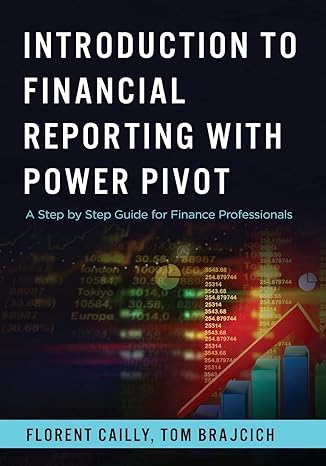Answered step by step
Verified Expert Solution
Question
1 Approved Answer
Port Ormond Carpet Company manufactures carpets. Fiber is placed in process in the Spinning Department, where it is spun into yam. The output of the
Port Ormond Carpet Company manufactures carpets. Fiber is placed in process in the Spinning Department, where it is spun into yam. The output of the Spinning Department is transferred to the Tufting Department, where carpet backing is added at the beginning of the process and the process is completed. On January 1, Port Ormond Carpet Company had the following inventories: Finished Goods $6,000 Work in Process-Spinning Department 1,300 Work in Process-Tufting Department Materials 2,100 4,800 Departmental accounts are maintained for factory overhead, and both have zero balances on January 1. Manufacturing operations for January are summarized as follows: Jan. 1 Materials purchased on account, $81,300 2 Materials requisitioned for use: 31 Fiber-Spinning Department, $42,000 Carpet backing-Tufting Department, $34,000 Indirect materials-Spinning Department, $3,300 Indirect materials-Tufting Department, $2,500 Labor used: Direct labor-Spinning Department, $26,800 Direct labor-Tufting Department, $18,700 Indirect labor-Spinning Department, $11,500 Indirect labor-Tufting Department, $11,700 31 Depreciation charged on fixed assets: Spinning Department, $5,300 Tufting Department, $3,300 31 31 31 Expired prepaid factory insurance: Spinning Department, $1,200 Tufting Department, $1,100 Applied factory overhead: Spinning Department, $21,700 Tufting Department, $18,400 Production costs transferred from Spinning Department to Tufting Department, $86,500 Production costs transferred from Tufting Department to Finished Goods, $153,600 Cost of goods sold during the period, $155,200 Required: 1. Journalize the entries to record the operations, using the dates provided with the summary of manufacturing operations. Refer to the chart of Departmental accounts are maintained for factory overhead, and both have zero balances on January 1. Manufacturing operations for January are summarized as follows: Materials purchased on account, $81,300 Jan. 1 2 Materials requisitioned for use: 31 Fiber-Spinning Department, $42,000 Carpet backing-Tufting Department, $34,000 Indirect materials-Spinning Department, $3,300 Indirect materials-Tufting Department, $2,500 Labor used: Direct labor-Spinning Department, $26,800 Direct labor-Tufting Department, $18,700 Indirect labor-Spinning Department, $11,500 Indirect labor-Tufting Department, $11,700 31 Depreciation charged on fixed assets: Spinning Department, $5,300 Tufting Department, $3,300 Expired prepaid factory insurance: Spinning Department, $1,200 Tufting Department, $1,100 31 Applied factory overhead: Spinning Department, $21,700 Tufting Department, $18,400 31 Production costs transferred from Spinning Department to Tufting Department, $86,500 31 Production costs transferred from Tufting Department to Finished Goods, $153,600 31 Cost of goods sold during the period, $155,200 Required: 1. Journalize the entries to record the operations, using the dates provided with the summary of manufacturing operations. Refer to the chart of accounts for the exact wording of the account titles. CNOW journals do not use lines for spaces or journal explanations. Every line on a journal page is used for debit or credit entries. Do not add explanations or skip a line between journal entries. CNOW journals will automatically indent a credit entry when a credit amount is entered. 2. Compute the January 31 balances of the inventory accounts.* 3. Compute the January 31 balances of the factory overhead accounts.* *Enter your amounts in positive value. 1. Journalize the entries to record the operations, using the dates provided with the summary of manufacturing operations. Refer to the chart of accounts for the exact wording of the account titles. CNOW journals do not use lines for spaces or journal explanations. Every line on a journal page is used for debit or credit entries. Do not add explanation or skip a line between journal entries. CNOW journals will automatically indent a credit entry when a credit amount is entered. Chart of Accounts PAGE 10 JOURNAL ASSETS ACCOUNTING FOLIATION 110 Cash General Ledger REVENUE 410 Sales DATE DESCRIPTION POST. REF. DEBIT CREDIT ASSETS LIABILITIES EQUITY 1 121 Accounts Receivable 125 Notes Receivable 610 Interest Revenue 2 3 7 B 9 13 15 16 17 18 20 21 22 25 126 Interest Receivable 131 Materials 141 Work in Process-Spinning Department 142 Work in Process-Tufting Department 151 Factory Overhead-Spinning Department 152 Factory Overhead-Tufting Department 161 Finished Goods 171 Supplies 172 Prepaid Insurance 173 Prepaid Expenses 181 Land 191 Factory 192 Accumulated Depreciation-Factory EXPENSES 510 Cost of Goods Sold 520 Wages Expense 531 Selling Expenses 532 Insurance Expense 533 Utilities Expense 534 Supplies Expense 540 Administrative Expenses 561 Depreciation Expense-Factory 590 Miscellaneous Expense 710 Interest Expense LIABILITIES 210 Accounts Payable 221 Utilities Payable 231 Notes Payable 236 Interest Payable 251 Wages Payable EQUITY 311 Common Stock 340 Retained Earnings 351 Dividends 390 Income Summary nstructions Chart of Accounts Journal Final Questions Jou Final Questions 1.J 2. Compute the January 31 balances of the inventory accounts. Enter your amounts in positive value. journal explanations. E or s Materials $ Work in Process: Spinning Department $ Tufting Department $ Finished Goods $ 1 2 3. Compute the January 31 balances of the factory overhead accounts. Enter your amounts in positive value. 3 Factory Overhead: 4 Spinning Department $ S Tufting Department $ 6 7 B 9 10 11 12 13 14 15 16 17 18 19
Step by Step Solution
There are 3 Steps involved in it
Step: 1

Get Instant Access to Expert-Tailored Solutions
See step-by-step solutions with expert insights and AI powered tools for academic success
Step: 2

Step: 3

Ace Your Homework with AI
Get the answers you need in no time with our AI-driven, step-by-step assistance
Get Started


